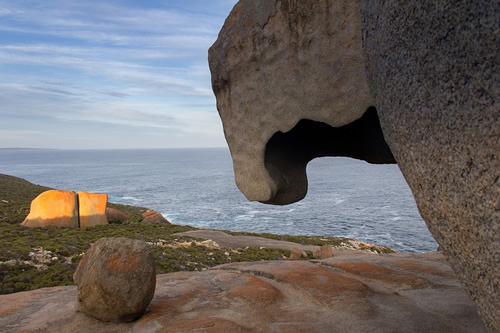More Than Kangaroos
Explore Australia’s “Most Wanted” Eco-Island
Article and Photo by Alison Gardner
Senior Travel Editor

|
|
Cliff-top rocks are a unique landmark of Kangaroo Island, Australia.
|
Kangaroo Island is not exactly on the main route to anywhere unless you happen to be traveling from South Australia to Antarctica. However, continental Europeans from a surprising variety of countries will tell you
not only where the island is but exactly why it is on their “Most Wanted” list of special places.
Australia’s third largest island is a 96 by 34 mile ecotourism treasure trove of rare and endangered species and fascinating geology. A 30-minute flight from Adelaide or a short ferry ride transports visitors
back 10,000 years to a period when separation from mainland Australia froze the island’s natural ecosystems in time.
Nature pretty much ruled until the early 1800s when European and American whalers and sealers, as well as a disreputable lot of deserters and escaped convicts, came ashore for rest, recreation, destruction, and not
much else. Much later, the rich red soil attracted pioneer farm families. Two-thirds of the island is now cultivated or grazed and one-third is protected in 14 diverse conservation parks and a national park of 75,000 hectares.
No Traffic Lights, No Predators on Kangaroo Island
Today, tourism and sheep are the economic engines. A half million sheep and 150,000 tourists annually roam the island under the watchful welcoming eye of 4,000 locals, many whose roots go back several generations and
all of whom are both proud and protective of Kangaroo Island. Independent and guided hiking and biking opportunities abound; car rentals and buses provide less active alternatives for exploration. There are no traffic lights or predators
(besides people) and few paved roads or vehicles. One brochure quaintly explains, “there are a lack of people-enhanced attractions.” Beyond the small towns and villages, vehicles themselves could well be added to the endangered
species list.
With permission and a guide, I wandered quietly through a sheep farm’s eucalyptus forest and observed dozens of koalas, adult and young, at close to eye level. Against a backdrop of tinkling sheep bells and the
surround-sound buzz of cicadas, these unperturbed teddy bears, stout bodies wedged into clefts in the branches, seemed entirely focused on counting sheep of their own. The 30,000 bumbling bears of Kangaroo Island have become a serious
threat to the limited food supply of eucalyptus leaves. Even paradise has its pains.
Seal Bay is another awe-inspiring experience, a protected conservation area and breeding beach for the rare Australian sea lion. During my visit, close to 100 of the 600-strong colony surfed the breakers and lay like
so many logs scattered in random confusion on the fine sand, nursing their pups and digesting a 2-day feed of fish gobbled far out to sea. Protected and cherished today by watchful rangers, these docile, approachable creatures were once
hunted to near extinction.
Nocturnal Fairy Penguins
I deliberately scheduled an overnight in Kingscote, the island’s largest town (population 1,400) to learn about the local fairy penguins and witness their remarkable adaptation to human presence. With good posture,
these flightless miniatures stand 14 inches tall, making them incontestably the world’s smallest penguin breed.
On the Kingscote waterfront, the Penguin Interpretive Centre offers nightly lectures and carefully controlled guided tours along the fishing harbor’s massive breakwater of jumbled boulders. As night descends,
a hundred or more penguins catapult onto shore, scramble up the boulders and make a bee-line for each bird’s family condo wedged between the rocks. At dawn they tumble back in the water for another day of fishing far out to sea.
Kangaroo Island is one of those destinations that generates sharp mental snapshots long after returning home: the stately flock of jet black swans cruising the ocean shoreline near my breakfast patio; the island’s
delicious sheep’s milk yogurt and specialty Brie and Camembert cheeses that I was severely tempted to try to sneak past customs; an intimate picnic under huge sugar gum trees watching a shy platypus paddle in leisurely fashion around
his personal billabong. Then there was the sprightly breeding colony of rare New Zealand fur seals perfectly timing their aquafit routines among the jagged rocks and ocean swells of Admiral’s Arch, and the Remarkable Rocks that have
served as an unmistakable cliff-top landmark to shipping for 200 years.
Next time I will certainly stay in one of the lovingly restored, period-furnished lighthouse keepers’ homes overlooking Remarkable Rocks and only a wind-tossed cliffwalk away from Admiral’s Arch. The park
service rents out these and other historic homesteads to adventurous visitors seeking seclusion and a taste of early settler history.
|
For More Info
For complete information on accommodation choices, ferry and air transportation, tour operators, car and bike rentals, and parks, visit Tourism Kangaroo Island.
As well as hotels and self-catered units, there are dozens of bed and breakfasts and farmstays with authenitc dining, classic furnishings and colorful historic connections. Kangaroo Island summers are hot
and dry; the winter season of June through August offers cooler temperatures, a greener landscape, and lots of wildflowers.
|
|

